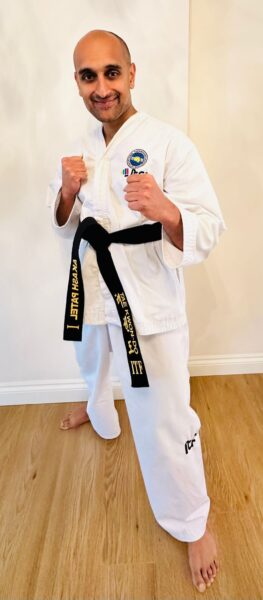Common Knee Injuries in Martial Arts
Read time: 6 mins

Article Summery: What are the common injuries while doing martial arts?
Common martial arts injuries often involve the knees due to twisting, pivoting, and high-impact movements. These include ACL and MCL sprains, meniscus tears, and patellar dislocations. Symptoms may involve pain, swelling, instability, or limited motion. Treatment ranges from rest and physiotherapy to surgery, with rehabilitation key for recovery. Strength training and gradual return-to-sport help prevent recurrence.
Martial arts, known for their intense physical demands and rigorous training, can sometimes lead to knee injuries. Those who practice martial arts may encounter common injuries such as tendinitis (inflammation of the tendons), a pulled groin, tweaked knees, ACL tears, patella dislocation, and meniscus tears, either during practice or competition, due to the dynamic movements required.
Understanding the knee injuries that may result from martial arts, along with their treatments, is essential to preventing further injury and ensuring a swift recovery.

Common Injuries in martial arts
Martial Arts Injuries
Ligament Sprains
- Anterior Cruciate Ligament (ACL) Sprains: The ACL, a critical component of the knee joint, connects the shin bone to the thigh bone. ACL sprains are a common type of knee injury in martial arts, often resulting from sudden changes in direction, pivoting, or landing awkwardly after a jump.
- Medial Collateral Ligament (MCL) Sprains: The MCL is situated on the inner side of the knee and is vulnerable to ligament sprains due to direct blows or twisting movements during martial arts practice.
Meniscus Tears
The meniscus functions as a shock absorber within the knee and protects the joint during movement. Most injuries in martial arts involve the knee, with meniscus tears being particularly common. A torn meniscus can occur when a twisting motion is made when the foot is planted and can cause knee pain and restricted range of motion.
Patellar Dislocations
Patellar dislocations occur when the kneecap slips out of its normal position; often caused by a direct blow or sudden directional change. Patellar dislocations are common in martial arts such as taekwondo and judo and can result in severe pain and instability in the knee joint.
Treatment for Knee Injuries
Anterior Cruciate Ligament Tears
- This approach is suitable for less active individuals or those with partial tears.
- It focuses on physiotherapy to strengthen the muscles surrounding the knee and improve knee alignment, thereby enhancing stability.
- Necessary for athletes or individuals with severe tears or instability.
- ACL Reconstruction Surgery involves reconstructing the ACL to restore knee function, using grafts taken from a patient’s hamstring tendon, patellar tendon, or a donor.
Rehabilitation:
- This is essential whether surgery is performed or not.
- Includes exercises to regain range of motion, strengthen the muscles, and improve proprioception, which is the body’s ability to sense joint movement and position.
- Individuals should undergo a gradual return-to-sport program under the guidance of a physiotherapist to ensure the knee is prepared for the demands of martial arts and any other contact sports.
Long-term Management:
- Since ACL tears can lead to chronic conditions like osteoarthritis, long-term management involves continuously monitoring knee health and maintaining muscle strength to help prevent injuries.
Treatment of Meniscal Tears
Conservative Management:
- Suitable for small tears located in the outer edge of the meniscus that have a good blood supply.
- Treatment involves RICE (Rest, Ice, Compression, Elevation) to reduce knee pain and swelling, coupled with physiotherapy to strengthen the knee joint and improve its range of motion.
- This is recommended when conservative measures fail to alleviate symptoms or when the tear causes significant knee pain or mechanical issues like locking.
- This minimally invasive procedure allows the surgeon to trim or repair the torn meniscus.
- Preferred for younger patients with tears in the vascularised (many blood vessels and therefore good blood supply) outer edge of the meniscus.
- The procedure involves suturing the torn edges to promote healing and maintain the meniscus’s shock-absorbing function.
Rehabilitation:
- Critical for recovery, whether treated conservatively or surgically.
- Focuses on restoring strength, flexibility, and balance to the knee, ensuring proper joint mechanics and function.
Activity Modification:
- Involves avoiding high-impact activities initially.
- Gradual return to activity under professional supervision helps prevent further injury to the knee.
Treatment of Patellar Dislocations
Acute Management:
- Reduction: The kneecap is manually repositioned by a doctor, which often requires anaesthesia to minimise pain and muscle spasms.
- Potential immobilisation: Post-reduction, the knee is occasionally immobilised with a brace or splint to protect the joint and facilitate healing.Most commonly, data now suggests gentle, early mobilisation for kneecap dislocations following reduction depending on the patient.
Rehabilitation:
- Physiotherapy: Strengthening the quadriceps (front of the thighs), hamstrings (back of the thighs), and hip muscles is crucial for improving knee stability and preventing recurrent dislocations.
- Range of Motion Exercises: Gradual restoration of knee flexibility helps prevent stiffness.
- Proprioception Training: Balance and coordination drills enhance joint position sense and neuromuscular control, reducing the risk of future dislocations.
Surgical Intervention:
- Required for recurrent dislocations or associated ligament damage.
- Surgical options include lateral release, medial patellofemoral ligament (MPFL) reconstruction, and tibial tubercle osteotomy to improve patellar alignment.
Activity Modification:
- Reducing stress on the knee by avoiding high-impact activities such as jumping or pivoting sports, especially in the initial recovery phase.
Knee injuries in martial arts are common due to the movements and high-intensity training involved. Effective treatment, be it conservative management, surgery, or targeted rehabilitation, is essential for restoring knee function and preventing further injury.
Martial art practitioners should seek professional medical advice for a proper diagnosis and personalised treatment plan, ensuring a safe and effective recovery process. By adhering to recommended rehabilitation and strength training protocols, most martial artists can return to their sport with confidence and reduced risk of future injuries.
Medically reviewed by Mr Akash Patel - BSc (Hons) MBBS MRCS MSc FRCS(Tr and Orth), Associate Professor (UCL) on 17/08/2024
Posted on: 20 August 2024
Last updated: 8 September 2025
Tags:
